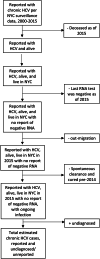Estimating the prevalence of chronic hepatitis C virus infection in New York City, 2015
- PMID: 29932040
- PMCID: PMC9507940
- DOI: 10.1017/S095026881800170X
Estimating the prevalence of chronic hepatitis C virus infection in New York City, 2015
Abstract
Chronic hepatitis C virus (HCV) infection is the most common blood-borne infection in the USA. Estimating prevalence is critical for monitoring diagnosis, treatment, and cure and for allocating resources. Surveillance data reported to the New York City (NYC) Health Department, 2000-2015, were used to estimate HCV prevalence in NYC in 2015. The numbers who died, out-migrated or whose last RNA test was negative were removed from the count of people reported with HCV. A simulation model was used to remove estimates of people whose infection spontaneously cleared or was cured and to add an estimate of people unaware of infection. The surveillance-based HCV prevalence in NYC in 2015 overall was 1.4% (95% certainty level (CL) 1.2-1.6%; n ≈ 116 000, 95% CL ≈99 000-135 000) and among adults aged ⩾20 years was 1.8% (95% CL 1.5-2.0%, n ≈ 115 000, 95% CL ≈99 000-134 000), lower than the 2010 estimate among adults aged ⩾20 years of 2.4% (n ≈ 147 000). Contributors to the decrease in HCV prevalence from 2010 to 2015 include both the availability of highly effective treatment and also deaths among an ageing population. The 2015 estimate can be used to set NYC-specific HCV screening and treatment targets and monitor progress towards HCV elimination.
Keywords: Estimating; hepatitis C; prevalence of disease; surveillance.
Figures
Similar articles
-
Development and Validation of Surveillance-Based Algorithms to Estimate Hepatitis C Treatment and Cure in New York City.J Public Health Manag Pract. 2018 Nov/Dec;24(6):526-532. doi: 10.1097/PHH.0000000000000688. J Public Health Manag Pract. 2018. PMID: 29227418
-
Estimating the prevalence of hepatitis C infection in New York City using surveillance data.Epidemiol Infect. 2014 Feb;142(2):262-9. doi: 10.1017/S0950268813000952. Epub 2013 May 9. Epidemiol Infect. 2014. PMID: 23657093 Free PMC article.
-
Estimating the prevalence of chronic hepatitis B virus infection--New York City, 2008.J Urban Health. 2012 Apr;89(2):373-83. doi: 10.1007/s11524-011-9653-7. J Urban Health. 2012. PMID: 22246675 Free PMC article.
-
Estimating Prevalence of Hepatitis C Virus Infection in the United States, 2013-2016.Hepatology. 2019 Mar;69(3):1020-1031. doi: 10.1002/hep.30297. Epub 2018 Nov 6. Hepatology. 2019. PMID: 30398671 Free PMC article. Review.
-
Estimating the true prevalence of hepatitis C in rhode island.R I Med J (2013). 2014 Jul 1;97(7):19-24. R I Med J (2013). 2014. PMID: 24983016 Free PMC article. Review.
Cited by
-
The Impact of Supportive Housing on Liver-Related Outcomes Among Persons With Hepatitis C Virus Infection.J Infect Dis. 2022 Oct 7;226(Suppl 3):S363-S371. doi: 10.1093/infdis/jiac292. J Infect Dis. 2022. PMID: 36208165 Free PMC article.
-
Hepatitis C virus-related policy-making in Iran: a stakeholder and social network analysis.Health Res Policy Syst. 2019 Apr 16;17(1):42. doi: 10.1186/s12961-019-0442-1. Health Res Policy Syst. 2019. PMID: 30992014 Free PMC article.
-
Association Between Time to First RNA-Negative Test Result Among People With Hepatitis C Virus Infection and Homelessness or Testing at a Correctional or Substance Use Treatment Facility, New York City.Public Health Rep. 2022 Nov-Dec;137(6):1126-1135. doi: 10.1177/00333549211049263. Epub 2021 Oct 25. Public Health Rep. 2022. PMID: 34694921 Free PMC article.
-
Comparing Routine HIV and Hepatitis C Virus Screening to Estimate the Effect of Required Consent on HIV Screening Rates Among Hospitalized Patients.Public Health Rep. 2022 Jan-Feb;137(1):102-109. doi: 10.1177/0033354921999170. Epub 2021 Mar 5. Public Health Rep. 2022. PMID: 33673778 Free PMC article.
-
Health Department Efforts to Increase Hepatitis C RNA Testing Among People Appearing Out of Care: Comparison of Outreach Approaches, New York City, 2017.Public Health Rep. 2020 Nov/Dec;135(6):823-830. doi: 10.1177/0033354920952068. Epub 2020 Sep 4. Public Health Rep. 2020. PMID: 32886566 Free PMC article. Clinical Trial.
References
-
- Alter MJ et al. (1999) The prevalence of hepatitis C virus infection in the United States, 1988 through 1994. New England Journal of Medicine 341, 556–562. - PubMed
-
- Davis GL et al. (2003) Projecting future complications of chronic hepatitis C in the United States. Liver Transplantation 9, 331–338. - PubMed
MeSH terms
LinkOut - more resources
Full Text Sources
Other Literature Sources


